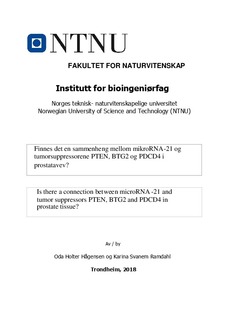| dc.contributor.advisor | Halgunset, Jostein | |
| dc.contributor.author | Hågensen, Oda Holter | |
| dc.contributor.author | Ramdahl, Karina Svanem | |
| dc.date.accessioned | 2019-05-25T14:00:38Z | |
| dc.date.available | 2019-05-25T14:00:38Z | |
| dc.date.issued | 2018 | |
| dc.identifier.uri | http://hdl.handle.net/11250/2598812 | |
| dc.description.abstract | miRNA er små deler av DNA som ikke koder for proteiner, men som i stedet festes til mRNA og kan regulere syntesen av proteiner ved å hemme translasjonen. miR-21 har en slik basesekvens at den kan bindes til mRNA for visse tumorsuppressorer, noe som gjør at det kan være knyttet opp mot utviklingen av kreft. Formålet med oppgaven var å finne ut om det er noen sammenheng mellom miR-21 og endret uttrykk av de tre ulike tumorsuppressorene PTEN, PDCD4 og BTG2 i prostatavev.
I dette prosjektet ble miR-21 detektert ved in situ hybridisering (ISH), mens de tre tumorsuppressorene ble detektert ved immunhistokjemi (IHC). Prøvematerialet som ble benyttet var formalinfiksert, parafininnstøpt prostatavev fra ti ulike pasienter. Blokkene ble sekvensielt snittet og fra hver pasient ble fire snitt farget med ISH og tre snitt med IHC, én for hver tumorsuppressor. De snittene som skulle sammenlignes var snittet rett etter hverandre. Dette er viktig for å få de samme kjertlene farget med de ulike metodene. Etter farging ble snittene vurdert ved mikroskopering.
Ved ISH-fargingen var at det mest atrofiske kjertler som ble positive, men også noen kjertler med irregulært fortykket epitel. Tumorvev var negativt. Etter hvert ble det funnet mønster som tydet på at de atrofiske kjertlene som lå i betente områder var de som ble farget oftest.
Det var vanskelig å finne noe klart mønster i uttrykket av tumorsuppressorene, og vi fant ingen sammenheng mellom uttrykket av miR-21 og de utvalgte tumorsuppressorene. Dette betyr at miR-21 trolig ikke inhiberer translasjonen av mRNA som koder for disse tumorsuppressorene. Det er mer sannsynlig at miR-21 inngår i en mer kompleks reguleringsmekanisme, og at denne kan være av betydning ved regenerasjon etter vevsskade med betennelse, noe som igjen kan utgjøre en forløper for kreft. | |
| dc.description.abstract | miRNA are small fractions of DNA which does not encode for proteins, but instead may attach to mRNAs. In that way, the miRNA contributes to regulate the protein synthesis by inhibiting the mRNA translation. miR-21 has the ability to suppress or degrade certain tumor suppresors and then contribute to cancer development. The purpose of this project is to see if there is any connection between microRNA-21 and a change in expression of the tumor suppressors PTEN, PDCD4 and BTG2 in prostate tissue.
In this project, miRNA-21 was detected and stained using in-situ hybridization (ISH), while the three tumor suppressors were detected with immunohistochemistry (IHC). The tissue sample used in the project was formalin-fixed paraffin-embedded prostate tissue from ten different patients. The sections were cut sequentially. For each patient, four sections were stained with in-situ hybridization and three sections were stained with immunohistochemistry, one section for each tumor suppressor. It is important that the sections stained with both in situ hybridization and immunohistochemistry are cut sequentially, because the two methods are being compered. After staining the sections were evaluated with microscopy.
The first thing that we noticed of the results from the ISH-staining, was that most of the positive stained glands was atrophic, but also glands with thickened epithelial layer was positive, while tumor glands was negative. Later a pattern was found that indicated that the atrophic glands lying in inflamed areas were the ones who got positively stained most often. As for the tumor suppressors, it was hard to find a clear pattern of in which glands they were expressed, nor was there any connection between which glands who got positive stained with ISH, and negative with IHC.
The results showed that there was no connection between miR-21 and the selected tumor suppressors, which means that miR-21 most likely do not affect mRNA who encodes for these tumor suppressors. It is more likely that miR-21 is associated with inflammations than tumor suppressors and precursors to cancer. | |
| dc.language | nob | |
| dc.publisher | NTNU | |
| dc.title | Finnes det en sammenheng mellom mikroRNA-21 og tumorsuppresorene PTEN, BTG2 og PDCD4 i prostatavev? | |
| dc.type | Bachelor thesis | |
